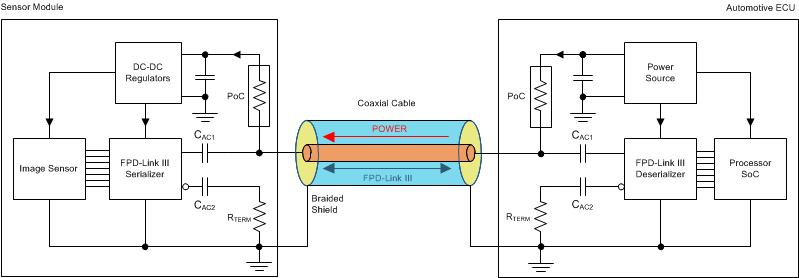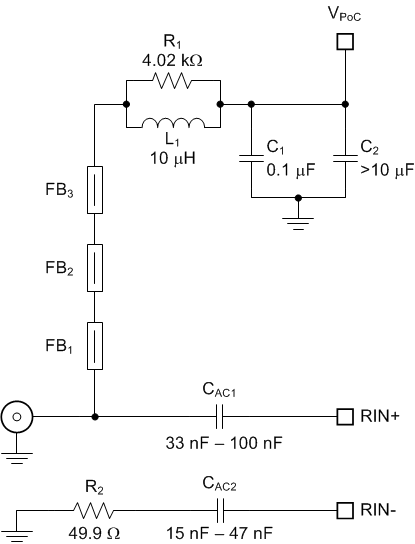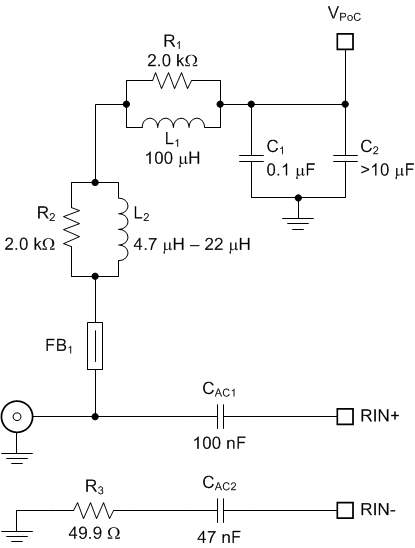ZHCSMR4A november 2020 – november 2020 DS90UB662-Q1
PRODUCTION DATA
- 1
- 1 特性
- 2 应用
- 3 说明
- 4 Revision History
- 5 Pin Configuration and Functions
- 6 Specifications
-
7 Detailed Description
- 7.1 Overview
- 7.2 Functional Block Diagram
- 7.3 Feature Description
- 7.4
Device Functional Modes
- 7.4.1 CSI-2 Mode
- 7.4.2 RAW Mode
- 7.4.3 MODE Pin
- 7.4.4 REFCLK
- 7.4.5 Receiver Port Control
- 7.4.6 Input Jitter Tolerance
- 7.4.7 Adaptive Equalizer
- 7.4.8 Channel Monitor Loop-Through Output Driver
- 7.4.9 RX Port Status
- 7.4.10 Sensor Status
- 7.4.11 GPIO Support
- 7.4.12 RAW Mode LV / FV Controls
- 7.4.13 CSI-2 Protocol Layer
- 7.4.14 CSI-2 Short Packet
- 7.4.15 CSI-2 Long Packet
- 7.4.16 CSI-2 Data Identifier
- 7.4.17 Virtual Channel and Context
- 7.4.18 CSI-2 Mode Virtual Channel Mapping
- 7.4.19 CSI-2 Transmitter Frequency
- 7.4.20 CSI-2 Output Bandwidth
- 7.4.21 CSI-2 Transmitter Status
- 7.4.22 Video Buffers
- 7.4.23 CSI-2 Line Count and Line Length
- 7.4.24 FrameSync Operation
- 7.4.25
CSI-2 Forwarding
- 7.4.25.1 Best-Effort Round Robin CSI-2 Forwarding
- 7.4.25.2 Synchronized CSI-2 Forwarding
- 7.4.25.3 Basic Synchronized CSI-2 Forwarding
- 7.4.25.4 Line-Interleaved CSI-2 Forwarding
- 7.4.25.5 Line-Concatenated CSI-2 Forwarding
- 7.4.25.6 CSI-2 Transmitter Output Control
- 7.4.25.7 Enabling and Disabling CSI-2 Transmitters
- 7.5
Programming
- 7.5.1 Serial Control Bus
- 7.5.2 Second I2C Port
- 7.5.3 I2C Slave Operation
- 7.5.4 Remote Slave Operation
- 7.5.5 Remote Slave Addressing
- 7.5.6 Broadcast Write to Remote Devices
- 7.5.7 I2C Master Proxy
- 7.5.8 I2C Master Proxy Timing
- 7.5.9 Interrupt Support
- 7.5.10 Error Handling
- 7.5.11 Timestamp – Video Skew Detection
- 7.5.12 Pattern Generation
- 7.5.13 FPD-Link BIST Mode
- 7.6
Register Maps
- 7.6.1
Digital Registers (Shared)
- 7.6.1.1 I2C Device ID Register
- 7.6.1.2 Reset Control Register
- 7.6.1.3 General Configuration Register
- 7.6.1.4 Revision / Mask ID Register
- 7.6.1.5 Device Status Register
- 7.6.1.6 PAR_ERR_THOLD_HI Register
- 7.6.1.7 PAR_ERR_THOLD_LO Register
- 7.6.1.8 BCC_WATCHDOG_CONTROL Register
- 7.6.1.9 I2C_CONTROL_1 Register
- 7.6.1.10 I2C_CONTROL_2 Register
- 7.6.1.11 SCL High Time Register
- 7.6.1.12 SCL Low Time Register
- 7.6.1.13 RX_PORT_CTL Register
- 7.6.1.14 IO_CTL Register
- 7.6.1.15 GPIO_PIN_STS Register
- 7.6.1.16 GPIO_INPUT_CTL Register
- 7.6.1.17 GPIO0_PIN_CTL Register
- 7.6.1.18 GPIO1_PIN_CTL Register
- 7.6.1.19 GPIO2_PIN_CTL Register
- 7.6.1.20 GPIO3_PIN_CTL Register
- 7.6.1.21 GPIO4_PIN_CTL Register
- 7.6.1.22 GPIO5_PIN_CTL Register
- 7.6.1.23 GPIO6_PIN_CTL Register
- 7.6.1.24 GPIO7_PIN_CTL Register
- 7.6.1.25 FS_CTL Register
- 7.6.1.26 FS_HIGH_TIME_1 Register
- 7.6.1.27 FS_HIGH_TIME_0 Register
- 7.6.1.28 FS_LOW_TIME_1 Register
- 7.6.1.29 FS_LOW_TIME_0 Register
- 7.6.1.30 MAX_FRM_HI Register
- 7.6.1.31 MAX_FRM_LO Register
- 7.6.1.32 CSI_PLL_CTL Register
- 7.6.1.33 FWD_CTL1 Register
- 7.6.1.34 FWD_CTL2 Register
- 7.6.1.35 FWD_STS Register
- 7.6.1.36 INTERRUPT_CTL Register
- 7.6.1.37 INTERRUPT_STS Register
- 7.6.1.38 TS_CONFIG Register
- 7.6.1.39 TS_CONTROL Register
- 7.6.1.40 TS_LINE_HI Register
- 7.6.1.41 TS_LINE_LO Register
- 7.6.1.42 TS_STATUS Register
- 7.6.1.43 TIMESTAMP_P0_HI Register
- 7.6.1.44 TIMESTAMP_P0_LO Register
- 7.6.1.45 TIMESTAMP_P1_HI Register
- 7.6.1.46 TIMESTAMP_P1_LO Register
- 7.6.1.47 TIMESTAMP_P2_HI Register
- 7.6.1.48 TIMESTAMP_P2_LO Register
- 7.6.1.49 TIMESTAMP_P3_HI Register
- 7.6.1.50 TIMESTAMP_P3_LO Register
- 7.6.2 CSI-2 Port Select Register
- 7.6.3 Digital CSI-2 Registers (Paged)
- 7.6.4 RESERVED Registers
- 7.6.5 AEQ Registers (Shared)
- 7.6.6
Digital RX Port Registers
- 7.6.6.1 BCC_ERR_CTL Register
- 7.6.6.2 BCC_STATUS Register
- 7.6.6.3 RESERVED Register
- 7.6.6.4 RESERVED Register
- 7.6.6.5 FPD3_CAP Register
- 7.6.6.6 RAW_EMBED_DTYPE Register
- 7.6.6.7 FPD3_PORT_SEL Register
- 7.6.6.8 RX_PORT_STS1 Register
- 7.6.6.9 RX_PORT_STS2 Register
- 7.6.6.10 RX_FREQ_HIGH Register
- 7.6.6.11 RX_FREQ_LOW Register
- 7.6.6.12 SENSOR_STS_0 Register
- 7.6.6.13 SENSOR_STS_1 Register
- 7.6.6.14 SENSOR_STS_2 Register
- 7.6.6.15 SENSOR_STS_3 Register
- 7.6.6.16 RX_PAR_ERR_HI Register
- 7.6.6.17 RX_PAR_ERR_LO Register
- 7.6.6.18 BIST_ERR_COUNT Register
- 7.6.6.19 BCC_CONFIG Register
- 7.6.6.20 DATAPATH_CTL1 Register
- 7.6.6.21 DATAPATH_CTL2 Register
- 7.6.6.22 SER_ID Register
- 7.6.6.23 SER_ALIAS_ID Register
- 7.6.6.24 SlaveID[0] Register
- 7.6.6.25 SlaveID[1] Register
- 7.6.6.26 SlaveID[2] Register
- 7.6.6.27 SlaveID[3] Register
- 7.6.6.28 SlaveID[4] Register
- 7.6.6.29 SlaveID[5] Register
- 7.6.6.30 SlaveID[6] Register
- 7.6.6.31 SlaveID[7] Register
- 7.6.6.32 SlaveAlias[0] Register
- 7.6.6.33 SlaveAlias[1] Register
- 7.6.6.34 SlaveAlias[2] Register
- 7.6.6.35 SlaveAlias[3] Register
- 7.6.6.36 SlaveAlias[4] Register
- 7.6.6.37 SlaveAlias[5] Register
- 7.6.6.38 SlaveAlias[6] Register
- 7.6.6.39 SlaveAlias[7] Register
- 7.6.6.40 PORT_CONFIG Register
- 7.6.6.41 BC_GPIO_CTL0 Register
- 7.6.6.42 BC_GPIO_CTL1 Register
- 7.6.6.43 RAW10_ID Register
- 7.6.6.44 RAW12_ID Register
- 7.6.6.45 CSI_VC_MAP Register
- 7.6.6.46 LINE_COUNT_1 Register
- 7.6.6.47 LINE_COUNT_0 Register
- 7.6.6.48 LINE_LEN_1 Register
- 7.6.6.49 LINE_LEN_0 Register
- 7.6.6.50 FREQ_DET_CTL Register
- 7.6.6.51 MAILBOX_0 Register
- 7.6.6.52 MAILBOX_1 Register
- 7.6.6.53 CSI_RX_STS Register
- 7.6.6.54 CSI_ERR_COUNTER Register
- 7.6.6.55 PORT_CONFIG2 Register
- 7.6.6.56 PORT_PASS_CTL Register
- 7.6.6.57 SEN_INT_RISE_CTL Register
- 7.6.6.58 SEN_INT_FALL_CTL Register
- 7.6.7 RESERVED Registers
- 7.6.8
Digital CSI-2 Debug Registers (Shared)
- 7.6.8.1 CSI_FRAME_COUNT_HI Register
- 7.6.8.2 CSI_FRAME_COUNT_LO Register
- 7.6.8.3 CSI_FRAME_ERR_COUNT_HI Register
- 7.6.8.4 CSI_FRAME_ERR_COUNT_LO Register
- 7.6.8.5 CSI_LINE_COUNT_HI Register
- 7.6.8.6 CSI_LINE_COUNT_LO Register
- 7.6.8.7 CSI_LINE_ERR_COUNT_HI Register
- 7.6.8.8 CSI_LINE_ERR_COUNT_LO Register
- 7.6.8.9 RESERVED Register
- 7.6.8.10 RESERVED Register
- 7.6.8.11 RESERVED Register
- 7.6.8.12 RESERVED Register
- 7.6.8.13 RESERVED Register
- 7.6.8.14 RESERVED Register
- 7.6.8.15 RESERVED Register
- 7.6.8.16 RESERVED Register
- 7.6.9 RESERVED (Shared)
- 7.6.10 Indirect Access Registers (Shared)
- 7.6.11
Digital Registers (Shared)
- 7.6.11.1 BIST Control Register
- 7.6.11.2 RESERVED Register
- 7.6.11.3 RESERVED Register
- 7.6.11.4 RESERVED Register
- 7.6.11.5 RESERVED Register
- 7.6.11.6 MODE_IDX_STS Register
- 7.6.11.7 LINK_ERROR_COUNT Register
- 7.6.11.8 FPD3_ENC_CTL Register
- 7.6.11.9 RESERVED Register
- 7.6.11.10 FV_MIN_TIME Register
- 7.6.11.11 RESERVED Register
- 7.6.11.12 GPIO_PD_CTL Register
- 7.6.11.13 RESERVED Register
- 7.6.12 RESERVED Registers
- 7.6.13
Digital RX Port Debug Registers (Paged)
- 7.6.13.1 PORT_DEBUG Register
- 7.6.13.2 RESERVED Register
- 7.6.13.3 AEQ_CTL2 Register
- 7.6.13.4 AEQ_STATUS Register
- 7.6.13.5 ADAPTIVE_EQ_BYPASS Register
- 7.6.13.6 AEQ_MIN_MAX Register
- 7.6.13.7 SFILTER_STS_0 Register
- 7.6.13.8 SFILTER_STS_1 Register
- 7.6.13.9 PORT_ICR_HI Register
- 7.6.13.10 PORT_ICR_LO Register
- 7.6.13.11 PORT_ISR_HI Register
- 7.6.13.12 PORT_ISR_LO Register
- 7.6.13.13 FC_GPIO_STS Register
- 7.6.13.14 FC_GPIO_ICR Register
- 7.6.13.15 SEN_INT_RISE_STS Register
- 7.6.13.16 SEN_INT_FALL_STS Register
- 7.6.14 RESERVED Registers
- 7.6.15 FPD3 RX ID Registers (Shared)
- 7.6.16 RESERVED Registers
- 7.6.17 RX Port I2C Addressing Registers (Shared)
- 7.6.18 RESERVED Registers
- 7.6.19 Indirect Access Registers
- 317
- 7.6.20
Digital Page 0 Indirect Registers
- 7.6.20.1 RESERVED
- 7.6.20.2 PGEN_CTL
- 7.6.20.3 PGEN_CFG
- 7.6.20.4 PGEN_CSI_DI
- 7.6.20.5 PGEN_LINE_SIZE1
- 7.6.20.6 PGEN_LINE_SIZE0
- 7.6.20.7 PGEN_BAR_SIZE1
- 7.6.20.8 PGEN_BAR_SIZE0
- 7.6.20.9 PGEN_ACT_LPF1
- 7.6.20.10 PGEN_ACT_LPF0
- 7.6.20.11 PGEN_TOT_LPF1
- 7.6.20.12 PGEN_TOT_LPF0
- 7.6.20.13 PGEN_LINE_PD1
- 7.6.20.14 PGEN_LINE_PD0
- 7.6.20.15 PGEN_VBP
- 7.6.20.16 PGEN_VFP
- 7.6.20.17 PGEN_COLOR0
- 7.6.20.18 PGEN_COLOR1
- 7.6.20.19 PGEN_COLOR2
- 7.6.20.20 PGEN_COLOR3
- 7.6.20.21 PGEN_COLOR4
- 7.6.20.22 PGEN_COLOR5
- 7.6.20.23 PGEN_COLOR6
- 7.6.20.24 PGEN_COLOR7
- 7.6.20.25 PGEN_COLOR8
- 7.6.20.26 PGEN_COLOR9
- 7.6.20.27 PGEN_COLOR10
- 7.6.20.28 PGEN_COLOR11
- 7.6.20.29 PGEN_COLOR12
- 7.6.20.30 PGEN_COLOR13
- 7.6.20.31 PGEN_COLOR14
- 7.6.20.32 PGEN_COLOR15
- 7.6.20.33 CSI_TCK_PREP
- 7.6.20.34 CSI_TCK_ZERO
- 7.6.20.35 CSI_TCK_TRAIL
- 7.6.20.36 CSI_TCK_POST
- 7.6.20.37 CSI_THS_PREP
- 7.6.20.38 CSI_THS_ZERO
- 7.6.20.39 CSI_THS_TRAIL
- 7.6.20.40 CSI_THS_EXIT
- 7.6.20.41 CSI1_TPLX
- 7.6.1
Digital Registers (Shared)
- 8 Application and Implementation
- 9 Power Supply Recommendations
- 10Layout
- 11Device and Documentation Support
- 12Mechanical, Packaging, and Orderable Information
8.1.1 Power Over Coax
The DS90UB662-Q1 is designed to support the Power-over-Coax (PoC) method of powering remote sensor systems. With this method, the power is delivered over the same medium (a coaxial cable) used for high-speed digital video data and bidirectional control and diagnostics data transmission. The method uses passive networks or filters that isolate the transmission line from the loading of the DC-DC regulator circuits and their connecting power traces on both sides of the link as shown in Figure 8-1.
 Figure 8-1 Power-over-Coax (PoC) System
Diagram
Figure 8-1 Power-over-Coax (PoC) System
DiagramThe PoC networks' impedance of ≥ 1 kΩ over a specific frequency band is typically sufficient to isolate the transmission line from the loading of the regulator circuits provided good layout practices are followed and the PCB return loss requirements given in Table 8-3 are met. The lower limit of the frequency band is defined as ½ of the bidirectional control channel's frequency, fBC. The upper limit of the frequency band is the frequency of the forward high-speed channel, fFC.
Figure 8-7 shows a PoC network recommended for a 4G FPD-Link III consisting of DS90UB63x CSI-2 Serializer and DS90UB662-Q1 pair with the bidirectional channel operating at 50 Mbps (½ fBCC = 25 MHz) and the forward channel operating at 4.16 Gbps (fFC ≈ 2.1 GHz).
 Figure 8-2 Typical PoC Network for a
4G FPD-Link III
Figure 8-2 Typical PoC Network for a
4G FPD-Link IIITable 8-1 lists essential components for this particular PoC network.
| COUNT | REF DES | DESCRIPTION | PART NUMBER | MFR |
|---|---|---|---|---|
| 1 | L1 | Inductor, 10 µH, 0.288 Ω maximum, 530
mA minimum (Isat, Itemp) 30-MHz SRF min, 3 mm × 3 mm, General-Purpose |
LQH3NPN100MJR | Murata |
| Inductor, 10 µH, 0.288 Ω maximum, 530
mA minimum (Isat, Itemp) 30-MHz SRF min, 3 mm × 3 mm, AEC-Q200 |
LQH3NPZ100MJR | Murata | ||
| Inductor, 10 µH, 0.360 Ω maximum, 450
mA minimum (Isat, Itemp) 30-MHz SRF min, 3.2 mm x 2.5 mm, AEC-Q200 |
NLCV32T-100K-EFD | TDK | ||
| Inductor, 10 µH, 0.400 Ω typical, 550
mA minimum (Isat, Itemp) 39-MHz SRF typ, 3 mm × 3 mm, AEC-Q200 |
TYS3010100M-10 | Laird | ||
| Inductor, 10 µH, 0.325 Ω maximum, 725
mA minimum (Isat, Itemp) 41-MHz SRF typ, 3 mm × 3 mm, AEC-Q200 |
TYS3015100M-10 | Laird | ||
| 3 | FB1-FB3 | Ferrite Bead, 1500 kΩ at 1 GHz, 0.5 Ω
maximum at DC 500 mA at 85°C, SM0603, General Purpose |
BLM18HE152SN1 | Murata |
| Ferrite Bead, 1500 kΩ at 1 GHz, 0.5 Ω
maximum at DC 500 mA at 85°C, SM0603, AEC-Q200 |
BLM18HE152SZ1 | Murata |
Application report Sending Power over Coax in DS90UB913A Designs (SNLA224) discusses and defines the PoC networks in more detail.
 Figure 8-3 Typical PoC Network for a
2G FPD-Link III
Figure 8-3 Typical PoC Network for a
2G FPD-Link IIIlists essential components for this particular PoC network.
| Count | Ref Des | Description | Part Number | MFR |
|---|---|---|---|---|
| 1 | L1 | Inductor, 100 µH, 0.310 Ω max, 710 mA MIN (Isat, Itemp) 7.2 MHz SRF typ, 6.6 mm × 6.6 mm, AEC-Q200 | MSS7341-104ML | Coilcraft |
| Inductor, 100 µH, 0.606 Ω max, 750 mA MIN (Isat, Itemp) 7.2 MHz SRF typ, 6.0 mm × 6.0 mm, AEC-Q200 | NRS6045T101MMGKV | Taiyo Yuden | ||
| 1 | L2 | Inductor, 4.7 µH, 0.350 Ω max, 700 mA MIN (Isat, Itemp) 160 MHz SRF typ, 3.8 mm × 3.8 mm, AEC-Q200 | 1008PS-472KL | Coilcraft |
| Inductor, 4.7 µH, 0.130 Ω max, 830 mA MIN (Isat, Itemp), 70 MHz SRF typ, 3.2 mm × 2.5 mm, General Purpose | CBC3225T4R7MRV | Taiyo Yuden | ||
| Inductor, 10 µH, 0.288 Ω max, 530 mA MIN (Isat, Itemp) 30 MHz SRF min, 3 mm × 3 mm, AEC-Q200 | LQH3NPZ100MJR | Murata | ||
| 1 | FB1 | Ferrite Bead, 1500 kΩ at 1 GHz, 0.5 Ω max at DC 500 mA at 85°C, SM0603, General Purpose | BLM18HE152SN1 | Murata |
| Ferrite Bead, 1500 kΩ at 1 GHz, 0.5 Ω max at DC 500 mA at 85°C, SM0603, AEC-Q200 | BLM18HE152SZ1 | Murata |
Application report https://www.ti.com/lit/an/snla224/snla224.pdf?ts=1602885821293 (SNLA224) discusses and defines the PoC networks in more detail.
In addition to the PoC network components selection, their placement and layout play a critical role as well.
- Place the smallest component, typically a ferrite bead or a chip inductor, as close to the connector as possible. Route the high-speed trace through one of its pads to avoid stubs.
- Use the smallest component pads as allowed by manufacturer's design rules. Add anti-pads in the inner planes below the component pads to minimize impedance drop.
- Consult with connector manufacturer for optimized connector footprint.
- Use coupled 100-Ω differential signal traces from the device pins to the AC-coupling caps. Use 50-Ω single-ended traces from the AC-coupling capacitors to the connector.
- Terminate the inverting signal traces close to the connectors with standard 49.9-Ω resistors.
The suggested characteristics for single-ended PCB traces (microstrips or striplines) for serializer or deserializer boards are detailed in Table 8-3. The effects of the PoC networks need to be accounted for when testing the traces for compliance to the suggested limits.
| PARAMETER | MIN | TYP | MAX | UNIT | ||
|---|---|---|---|---|---|---|
| Ltrace | Single-ended PCB trace length from the device pin to the connector pin | 5 | cm | |||
| Ztrace | Single-ended PCB trace characteristic impedance | 45 | 50 | 55 | Ω | |
| Zcon | Connector (mounted) characteristic impedance | 40 | 50 | 62.5 | Ω | |
| RL | Return Loss, S11 | ½ fBC < f < 0.1 GHz | –20 | dB | ||
| 0.1 GHz < f < 1 GHz (f in GHz) | –12 + 8 × log(f) | dB | ||||
| 1 GHz < f < fFC | –12 | dB | ||||
| IL | Insertion Loss, S12 | f < 0.5 GHz | –0.35 | dB | ||
| f = 1 GHz | –0.6 | dB | ||||
| f = 2.1 GHz | –1.2 | dB | ||||
The VPOC noise must be kept to 10 mVp-p or lower on the source / deserializer side of the system. The VPOC fluctuations on the serializer side, caused by the sensor's transient current draw and the DC resistance of cables and PoC components, must be kept at minimum as well. Increasing the VPOC voltage and adding extra decoupling capacitance (> 10 µF) help reduce the amplitude and slew rate of the VPOC fluctuations.
Figure 8-3 shows a PoC network recommended for a "2G" FPD-Link III consisting of a DS90UB633A-Q1 serializer and DS90UB662-Q1 with the bidirectional channel operating at the data rate of 2.5 Mbps (½ fBC = 1.25 MHz) and the forward channel operating at the data rate as high as 1.87 Gbps (fFC ≈ 1 GHz).